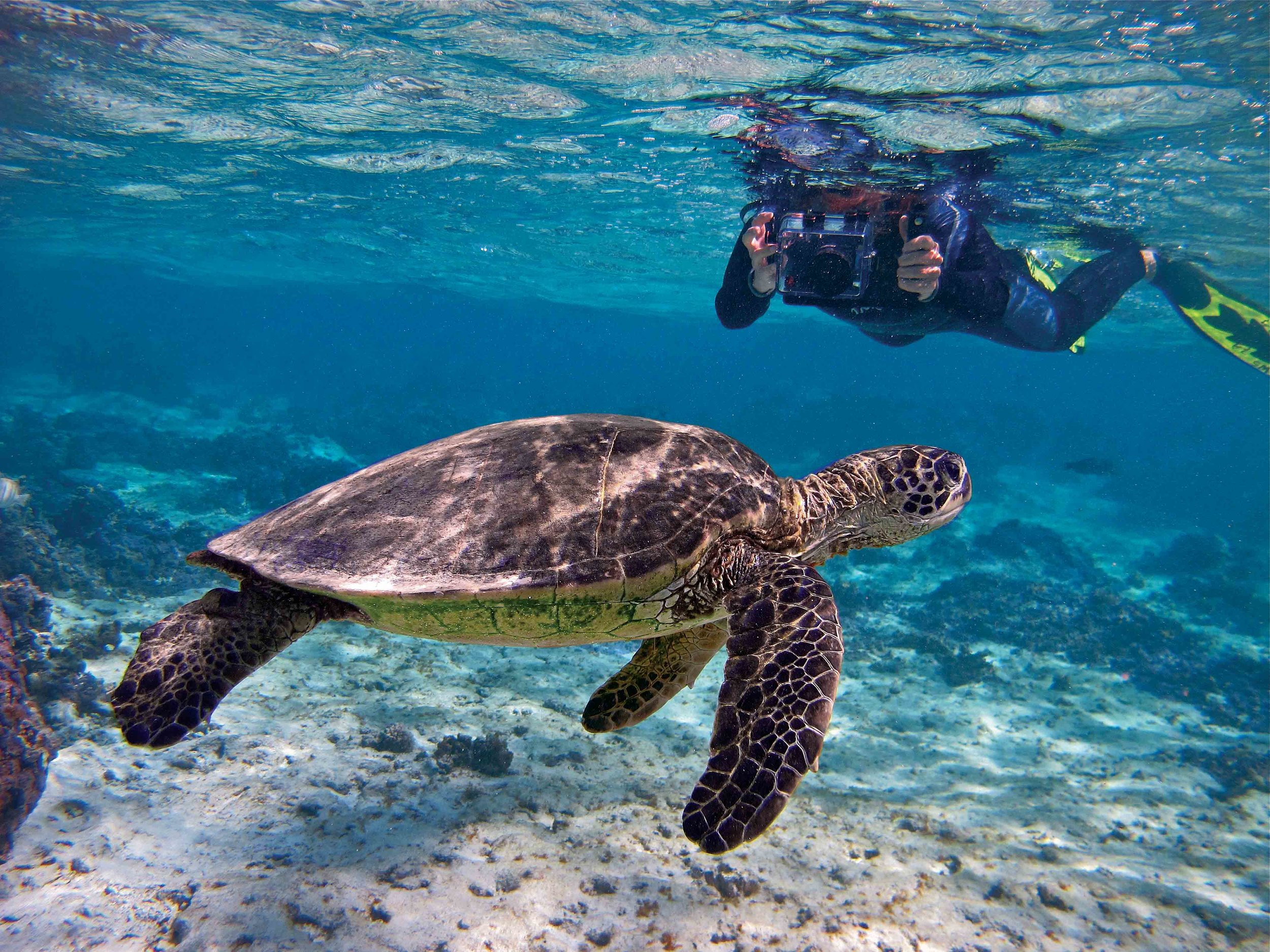Picture Perfect Photography for Turtle Monitoring
A snorkeler photographs a green turtle. Researchers are exploring ways to combine photography and computer software to identify individual turtles. © WAYNE SENTMAN
By STEPHEN G. DUNBAR and HARUKA ITO
In July 2010, a local fisherman in Roatán, Honduras, brought us two hawksbill turtles that he had accidentally captured while fishing. In the past, the turtles would simply have been killed and eaten, but since 2006 we have been working with fishermen in Roatán to take their incidentally captured turtles as part of the ongoing research of the Protective Turtle Ecology Center for Training, Outreach, and Research, Inc. (ProTECTOR). Each turtle brought to us (or that we capture during surveys) is systematically weighed, measured, flipper tagged, etched with a number on the shell, and photographed. If the turtle is recaptured, it provides us with important information about its movements, growth rate, and life history, and it can contribute to our understanding of the population as a whole.
Upon examining the turtles brought to us that day in July 2010, we clearly knew that we had previously tagged and released them. However, their tags had been removed and the shell etching had almost fully healed over, making them unidentifiable using our normal methods. Our only hope was to compare new photographs of them to our database of hundreds of old photographs so we could find a match. After much searching, we found matches for both turtles and determined that they had originally been captured and released in 2007. We learned that each had gained more than 6 kilograms (13 pounds) and had grown in length and width since their last capture, which was important information for our research. But searching through the hundreds of photographs was a tedious and time consuming process, and it was not a method we could regularly use.
However, the process made us wonder: could we digitally manipulate the photographs in a way that would allow a computer to take on the task of searching the photo database to come up with a possible match? If digital matching were possible, not only could it help us the next time a turtle’s tag was lost or unreadable, but also it could replace the tagging process altogether. After all, recapturing sea turtles in the water requires significant resources, including watercraft, fuel, time, and people power, and it may also cause the turtles unnecessary stress. Finding a way to identify and reidentify turtles over time without the need to physically capture them could open up many possibilities for us and for hundreds of other projects that use similar techniques. So we began to look for an answer.
“Finding a way to identify and reidentify turtles over time without the need to physically capture them could open up many possibilities for us and for hundreds of other projects that use similar techniques.”
Although photographic identification of animals is not a new technique, relatively few sea turtle studies have put it to use. For turtles, the process requires that baseline photographs be taken of the turtle’s head or face to create a database against which new photos can be carefully compared for matching scale patterns. The method works because the scale pattern of each turtle’s face is unique, and though the scales change in size as the turtle grows, they do not change in orientation or pattern. Scale patterns can, therefore, be used to reidentify individual animals—even several years after the initial encounter. A few previous studies have had success with this technique, but the process has involved manually searching through a database of turtle photographs, which can be a daunting and laborious task.
The face of a hawksbill turtle, illustrated to show the “spots” at the junctions between scales that were used in testing pattern recognition software. © STEPHEN DUNBAR
We could not find a computer program that would allow us to trace the shape and arrangement of the scales and compare them from one photo to another, but we did find the Interactive Individual Identification System (I3 S) program, which identifies patterns of spots and has been used for matching photographs of whale sharks. We decided to try using the program to “spot” the junction of each scale in a select area of scales on the face and head of our turtles, and the program quickly and easily found matches of the new photographs to the old photographs of our two recaptured turtles.
After that promising first result, we began running single-blind tests for turtle photographs in the database and random turtle photographs from outside sources, and we found that I3 S did a good job of detecting potential matches quickly! We have since been testing a new version of I3 S (Pattern, a version specifically designed for turtles), and though it does help with identification, we have found that it has some limitations. A more dynamic photo ID detection and manipulation system is ultimately still needed for sea turtles.
Even with limitations of the software that is currently available, we see far-reaching potential for use of a global computer-assisted photo ID system for sea turtles. Such a system would help scientists track movements and monitor growth in individual turtles in different areas of their ranges. A global photo database could also be open to citizen science contributions by divers and snorkelers, thus extending the effect of sea turtle conservation efforts around the world.
This article originally appeared in SWOT Report, vol. 10 (2015). Click here to download the entire article as a PDF.


